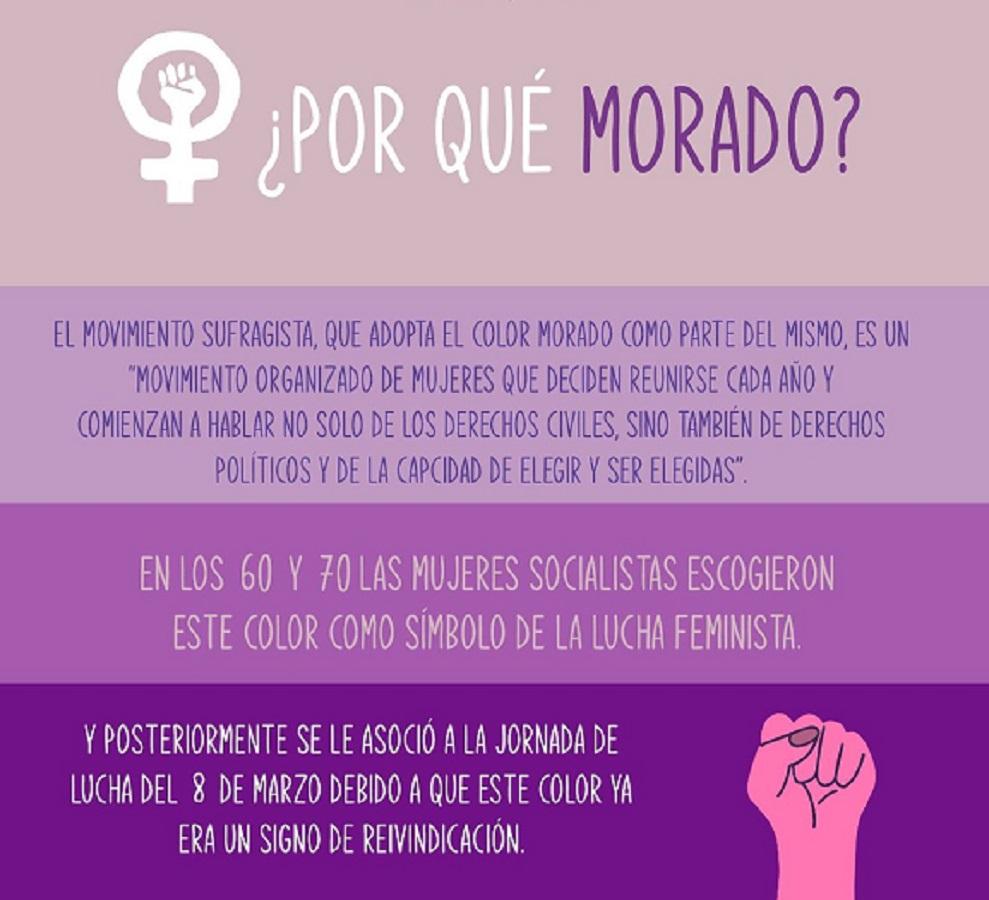¿Cuánto sabes sobre feminismo?
Read article
Issues / current
Beyond March 8
Writer
March 8, 2021 ·11: 42 updated to
Reading:
ActualidadHistoria del feminismoPurple or purple is the tone par excellence associated with feminist struggle. In the massive demonstrations of recent years the purple tones are the protagonists in the streets, where those who want to show their support for the cause use them in multiple ways: on clothes, on posters or handkerchiefs that make a message more visible, the demand for equal rights without importance of gender, in short, feminism.
But since when is purple a feminist color and why? Well, there are several theories that have tried to answer this question. One of the most simplistic explanations that attempted to give an answer was that the purple color is obtained from mixing blue with pink, the colors traditionally associated with each of the genres. But the truth is that there are other theories that refer to historical facts which, mixed with a component perhaps closer to fiction, provide a more plausible and legendary explanation.
To learn more
How to beat stress and pressure to achieve big success in Examinations?-DigiTeck-World of Digital Technology https: / / t.co / SIMfLkZ9oP
— didyouknow Sat Jan 28 18:17:24 +0000 2017
Read article

One of the toughest episodes lived in the feminine key shares demands with the workers' struggle, an area in which women have been doubly aggrieved by discrimination. Although the 18th century was a period of great industrial progress thanks to technological advances, the 19th century witnessed the birth of workers' movements demanding improvements in living conditions that had been particularly damaged by this evolution of industry. Population movements from the countryside to the cities, places where factories were concentrated, were massive and extended also to the twentieth century, when migrations also crossed international borders, continents and oceans.
This was the case with many New York factories, whose workforce reflected all the social changes experienced over the past 100 years. At the Triangle Waist Co. Textile factory, the majority of female workers were young women from various European countries who had crossed the Atlantic in search of more work and a better life. There, they survived on a 52-hour day a week, paid with a meagre salary, and which led them to terrible living conditions. Against any security measures, factory officials kept access to the building closed to prevent theft, which is common in the area. The disaster began when a fire broke out on the premises on 25 March 1911. Although it was never possible to know whether it was because of a badly switched butt or because of a spark in the engine of a sewing machine, it appears that the fire originated in an unfortunate accident. In any case, the fact is that most of the workers were unable to escape the flames because the building was closed and the doors could not be opened quickly enough.
A total of 146 people were killed and 70 seriously injured, most of them women. As firefighters also had difficulty accessing the facilities, the fire consumed almost all of the factory, with the machinery and materials inside it. It is said that the smoke from the building, which could be seen from almost the entire city, was purple due to the fabrics used in this shirt factory. For this reason, from that moment on, the purple was associated with the feminist struggle, as the Triangle Waist Co. became a symbol of the unjust situation in which many women lived badly.
On the other hand, although the suffragist movement already had a certain trajectory behind its back, the early years of the twentieth century were the moment when its demands took on a more forceful face. These women who asked for the right to vote also adopted purple as a symbolic color of their struggle, along with the white and green that also characterized them. Emmeline Pethick-Lawrence, one of the most prominent suffragists, explained it this way: "the violet, color of the sovereign, symbolizes the royal blood that runs through the veins of every fighter for the right to vote, symbolizes his awareness of freedom and dignity. White symbolizes honesty in private and political life. And green symbolizes hope in a new beginning. "
Since then, every 8 March, the purple color floods the streets of many cities around the world turned into more than just a color. It has been associated with a feminist struggle that year after year recalls the references that preceded it, thanks to which, today and in the future, equality between men and women will continue to be claimed.
To learn more
Read article
Related Articles